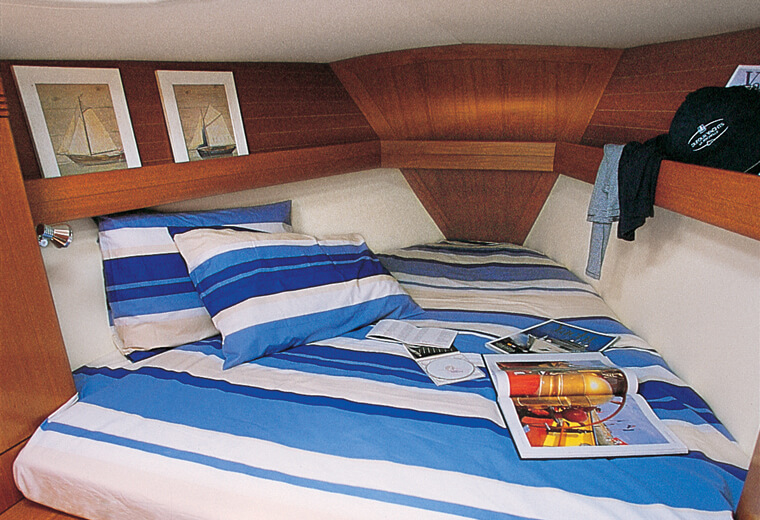Last November, Ale and I treated ourselves to a getaway from the world, and it was beautiful. Not that I didn’t fear a week in tête à tête in the micro space of a sailboat. Actually, several weeks before the departure, I could only see the bad points of this plan, but once on board, we only experienced positive things and feelings.
How to plan a sailing holiday in Lanzarote
Once decided we were heading to Lanzarote – ideal in late November per climate (22/26 °), only a few hours of direct flight from Italy, relatively low prices to be in Europe, and the wind never under 10 knots – I started to analyze all the charter websites I could find online, and after several days I received an excellent offer from Cruceros Canarios.
We then rented a Dufour 34, normally allowed for six people and therefore absolutely practical and comfortable for the two of us, for € 1,300 inclusive of cleaning, full tank, tender, and all the services in Marina Rubicon. The boat is almost always rented, and therefore its wear is quite evident, especially in terms of sails and ropes, but perhaps they were changed after our holiday… During the week, we had some problems, but the guys of the charter were always available and helpful, and everything was solved promptly.
To rent the sailboat without a skipper, which normally costs from € 150 to € 250 per day according to the charter, you need a captain on board, meaning someone who has the license. Needless to say, I was the hub…
To board, you have to make an appointment with a sailor of the charter, and it is absolutely not enough to get the keys! To avoid problems and extra costs at the end of the sailing trip, it is essential to scroll through and test all the items on the board checklist (heating, lights, etc.) and sign the document once all agreed and checked.
As for the life on board and the what-to-pack question, please do read the post I wrote to sum it up.
The harbor of Marina Rubicón in Lanzarote
This small marina is located in the south of Lanzarote, between Playa Blanca and the famous beach of Papagayo, and takes its name from the Mountain Roja; a reddish volcano dominates this part of the island.
Not only it is an aesthetically beautiful harbor, looking like a perfect small fishing village, but it is also very well managed. The moorings are very comfortable, and the connections to water and electricity are ideally positioned. The sailors are always available and come in a few minutes from the radio call. The gas station is located at the harbor entrance, as well as the sail loft and warehouse for servicing. Parking spaces are not far from the piers and are all free. The supermarket is next to the docks and is open until 11 p.m.
In addition to the essential services mentioned above, there are bars, restaurants, shops, and pubs to suit all tastes and budgets, and all have free WiFi, although a very slow one. Speaking of wifi, the only poor service of the harbor is actually this one. You are entitled to a single password per boat, valid for only one device and only for four days. Then you have to go back to the administration office and request a new one.
Sailing in Lanzarote is simply thrilling
In my first post, I described Lanzarote as an Eden of lava for its convoluted lava flows, the sand that goes from total black to shiny red, the spectacular caves and coves, and its lunar atmosphere but it is even more surreal when viewed from the sea. Lanzarote is also a sailing Eden, also perfect for other water sports all year long. When you say a paradise…
The wind never fails, and it offers fantastic sailing trips for those coming from the Ligurian Sea. Being in the middle of the Atlantic, changes of direction are frequent during the day and the waves. In short, it’s impossible to get bored, especially if you are only two!
The first day we sailed on La Graciosa, a scarce nature reserve, declared a natural park in 1982 and free of driveways. After about twelve hours sailing, we got there a little after sunset, almost all upwind with 7 to 10 knots, and therefore in total relax.
Following the advice of a sailor at the harbor, we dropped anchor in Caleta del Sebo, a small inlet with a sandy seabed that looked just perfect… perfect it was not for the lighting storm that raged in less than an hour, the strong wind and the tide we weren’t aware of. To say that the night was not the best one wouldn’t be clear enough, but now it’s definitely a wonderful memory. My commander stood up countless times to check the tightness of the anchor and the distance from the seabed (the tide in November and December falls of 3m50). Before dawn, we were ready to set sail, just like the two sailboats that spent the night at anchor in front of us, under the Mirador del Río.
The day of sailing to the south has been tumultuous for strong wind, uninterrupted heavy rain, and stormy ocean, and we didn’t even miss small incidents, such as the easy-bag breaking with a consequent action-recovery of the mainsail. Even like this, I liked it. I liked it because it taught me a lot, because it revealed the extent to which we are close and because for an adventure lover like me it was perfect 😉
Pointing the helm towards Fuerteventura instead, in just over an hour, you reach the wild Isla de Lobos, a rocky islet know for being an excellent fishing spot, located in front of the harbor of Corralejo, that with its tall skyscrapers in by the sea didn’t inspire us at all. In this small volcanic paradise, we spent a romantic but forced night at anchor. After a lovely lunch in the sun, when the time to weigh anchor arrived, we realized to be stranded … Ale dived, but the seabed during the day is far too deep. Luckily some guys sailing to Fuerteventura shouted us to wait for low tide in the early morning to refloat. Destiny gave us a stunning sunset and a moving sunrise. Just perfect romance.
Raising the moorings in Marina Rubicón, there are several options, though. By choosing a relatively short sailing and a day of relaxation, pointing north in a few minutes, you reach the coves of Papagayo and Gongrio, both ideal for a night at anchor and a swim in the ocean crystal waters.
Continuing the voyage northward, there are various marinas, but the landscape is not very picturesque, because here the coast is mainly exploited from the commercial point of view. The island gets back to its beauty and nature once it passed Punta Mujeres, but it is already at about nine hours of sailing…
Let’s say it was an “all or nothing” experience, and it went amazingly well. Now I have to get a promotion 😉
Oh, whatever your route is, don’t forget the rum for Neptune!



















